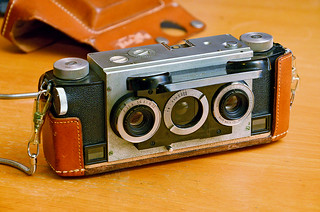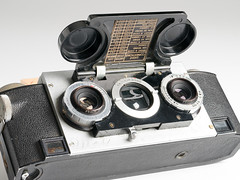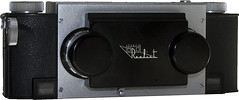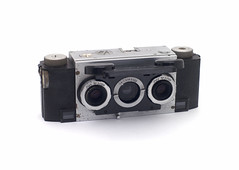Stereo Realist
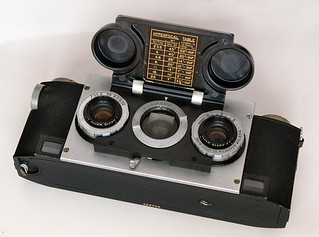
|
| Stereo Realist Model 1041 image by Geoff Harrisson (Image rights) |
The Stereo Realist, is the best selling 35mm stereo camera of all time. It is a full-featured 35mm stereo camera with rangefinder focusing, takes photos in the "5-perf stereo" format (also known as "Realist" format or 5-p), producing twin 23x24 mm images, the length along the film being that of five perforations. It was designed by Seton Rochwite[1] and made by the David White Company in 1947, after 4 years of development. It was released in two very similar models, with different lenses (anastigmat triplet f/3.5 or a Tessar-like 4 element f/2.8) and shutter, with several improvements such as double exposure prevention and film transport introduced through the life of the camera.
The camera is noticeably odd in design even compared to some other stereo cameras, but it is designed for accuracy and usability, with most of the kinks and bugs having been fixed before launch. The viewfinder and rangefinder are separate and are located at the bottom of the camera, it has a finger-wheel for focusing, with DoF markings, an integral lens cap that also blocks the viewfinder, indicating when it is in use, and internal linkages for the shutter and aperture. The coupled rangefinder is separated from the viewfinder and is of the split image type, the entire upper and lower halves of the image are separate and focus is achieved when the images coincide. The camera is easy to maintain and is very rugged.
The stereo effect is optimized for middle distances, and can be noticeably subtle beyond 100 feet. Both close-up attachments, to allow closer focus, and distance attachments, to enhance the stereo effect at long distances, were produced for this camera.
Description
The Stereo Realist is a well-featured 35mm stereo camera, it introduced the 5p (23x24mm) format which allows the advance of film by 10 sprockets each time, with image pairs separated by images from the other pair. This format allows taking 28 pairs of images in a 36 exposure roll, or 19 pairs in a 24 exposure roll.
Seton Rochwite developed the camera himself and presented a prototype to the David White company in 1943, it took several years of development, in which most of the kinks were solved before the camera was sold. The camera was an instant success.
The camera is well built, with lenses that focus internally using a wheel on the side which has DoF markings. An integral cover protects the lenses and covers the viewfinder to prevent the chance of shooting while closed. The viewfinder is an unusual design in which a prism redirects the light path down from a large lens at the center of the camera to the eyepiece, near the bottom of the camera. Next to this is the rangefinder eyepiece. This low placement requires the photographer to hold the camera fairly high on his or her face. The rangefinder is a split-image type with a very long effective base, coupled to the distance dial but separate from the viewfinder. In theory this can give it greater accuracy than many short-base finders like those on Leica copies. This is however contingent on the finder being well calibrated.[2] The camera is easy to maintain and repair; unfortunately spare parts must be scavenged from other cameras.
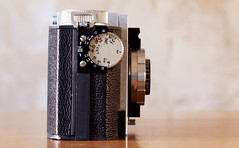
|
| Focusing knob with depth-of-field scale image by Kathryn Froilan (Image rights) |
| ||
| Stereo Realist 3.5 (1041) [3] | ||
|---|---|---|
|
Manufacturer: David White Co., Milwaukee, WI, USA Date of Production: About 1947[4] Type of Camera: viewfinder/rangefinder camera Film 135 cartridge Size 175 x 65 x 59 mm (W x H x D) Weight 820 grams (1,125 grams with everready case) Lens Separation 69.28 mm Image Format 25.40 x 23.42 mm (W x H) Image Window Separation 70,92 mm Lenses David White Anastigmat (glass, matched), 1:3.5/35 mm clip-on filters 20 mm Diaphragms Iris diaphragms between the lenses, continuously adjustable from f/3.5 to f/22 Focusing Manual, 2½ ft. - infinity. Movement of the film plane Shutter Double lamellar type shutter, behind the lenses. Cocked with separate lever Shutter Speeds 1/150, 1/100, 1/50, 1/25, 1/10, 1/5, ½, 1 sec. and "B" and "T" Viewfinder Optical reflex viewfinder (approx. 0,5x). Parallax-free. Rangefinder linked with distance setting, 123 mm baseline Film Loading Manual Film Transport Manual, with transport knob by 10 sprocket holes (= 47.5 mm), sprocket wheel on top Film Rewinding Manual. Unlocking with rewind release knob. Rewind knob. Frame Counter Additive, 1 to 36. Manual reset. Flash Contact Hot Shoe Tripod Socket ¼“ / 20 TPI Special Features Double exposure prevention, eyelets for carrying-strap, cable realease provision. Accessories Operating instructions, everready case, viewers, Bulb Flash, Projector, Mounting Kit |
| Stereo Realist 2.8 (1042)[5] |
|---|
|
Manufacturer: David White Co., Milwaukee, WI, USA Date of Production: 1951 Type of Camera: viewfinder/rangefinder camera Same as 1041 except Lenses David White Anastigmat (glass, matched), 1:2.8/35 mm clip-on filters 20 mm Shutter Double lamellar type shutter, behind the lenses. Cocked with separate lever Shutter Speeds 1/200, 1/100, 1/50, 1/25, 1/10, 1/5, ½, 1 sec. and "B" and "T" Viewfinder Optical reflex viewfinder (approx. 0,5x). Parallax-free. Rangefinder linked with distance setting, 123 mm baseline Film Loading Manual Film Transport Manual, with transport knob by 10 sprocket holes (= 47.5 mm), sprocket wheel on top Film Rewinding Manual. Unlocking with rewind release knob. Rewind knob. Frame Counter Additive, 1 to 36. Manual reset. Flash Contact Hot Shoe Tripod Socket ¼“ / 20 TPI |
The controls are dials around each of the three lenses on the front. The shutter speed is adjusted via a pronged dial around the viewfinder lens, and the ring around either taking lens will adjust both lenses' aperture, though depending on the year the dial may only be marked on one side.
The shutter is not cocked by advancing the film, and releasing the shutter does not unlock the winding knob. Instead one must cock the shutter with a lever, and press a button before starting to wind. Additionally the frame counter must be set to "1" by hand after shooting the initial blank frames.
The film is loaded by removing the back of the camera, passing the film under the sprocket guard, and advancing. Film advance requires the pressing of the film wind release button until the film counter clicks.
Format
The format which the Realist popularized is widely regarded as the ideal 35mm stereo format. Each individual frame, or singlet, is one sprocket wider than half-frame format, or 5/8's of a full 135 frame (24x23mm). This gives a mild portrait orientation. Each pair is separated on the film by two intervening frames, one from the previous pair and one from the succeeding one (there is a blank frame after the first frame on the roll, and before the last frame). Each advancement is by the width of two frames, which is the mechanically simplest way of interleaving frames in the desired ratio.
One may easily see, by plugging in alternate values, that any other frame width (in multiples of the sprocket distance, by necessity) cannot be interleaved with the distance necessary for human-like stereoscopy. For this reason, it is probable that several inventors originated this format at different times. The Kodak Stereo, Delta Stereo and several others from the same time are not necessarily copying each other, though it is probable that at least some of them are.
In order to mount the slides in stereo frames, the images were separated (cut) and mounted in pair (A for right and B for left). Given the way pictures were taken, a normal sequence of frames would be 1A-blank-2A-1B-3A-2B-4A-2B-etc.. It was important to recognize which side each of the images in a pair belonged, in the Stereo Realist a small notch mark is seen at the edge of the A frame (right hand image).[2]
History
The Stereo Realist camera was designed by Seton Rochwite, who approached the David White Company in the early 1940s. This camera was designed without being part of a large company and all the components were designed in house.[6][7]
The high quality of the camera, the impact and realism of the stereo pcitures in color, and the aesthetic appeal made the camera very popular. Until the introduction of the Kodak Stereo in 1955 there was barely any competition. The Stereo Realist was used by many people, despite being expensive at the time ($160 in 1949) and attracted celebrities throughout the 50s. The most notable user of the camera was silent film star, Harold Lloyd, who not only used the camera to make portraits of Marilyn Monroe and Bettie Page, among others but also wrote the foreword of the Stereo Realist Manual[2]. Advertisements of the time featured celebrities, many who were friends of Lloyd's and in his stereo camera club. Celebrities in these advertisements included Vincent Price (on the set of House of Wax), Edgar Bergen, John Wayne, James Cagney, Bob Hope, Joan Crawford, Doris Day, Cecil B. Demile, and Frank Capra. President Dwight D Eisenhower was also seen with the camera many times.

|
| Realist Macro Stereo Model 1060 with close-up lens kit image by Richard Bugg (Image rights) |
The popularity of the camera began to wane as the Stereo craze faded, but David White (Realist Inc) continued production into the 60s. In 1971, the Realist Macro Stereo (Model 1060) was added to the line of cameras.[8] This is a rather different camera, having two small lenses mounted together on the left side of the body, in a rim-set shutter with speeds 1 - 1/125 second, plus 'B' and 'T'. There is no focusing, or even a viewfinder; the camera is focused by the use of close-up lenses.
Daid White closed the division in 1972, selling the assets to Ron Zakowski. Today, the trademark is owned by John J. Zelenka, a stereo photographer.
Accessories
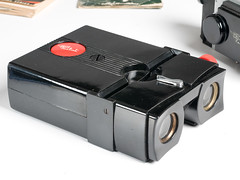
|
| David White stereo viewer image by Peter M Lerman (Image rights) |
- Wide-angle lenses
- Filters with filter case
- Flash
- Leather Case
- Leather ever-ready case
- Mounting kit, includes film chip sorting box, heat seal, film cutter, and slide mounter.
- Electronic Viewers: Red Button, Green Button, White Button, Gold Button
- Projector
- Silver screen, for projection
- Slide Mounts: Metal, Paper, Plastic, Glass
Notes
- ↑ Obituary of Seton Rochwite
- ↑ 2.0 2.1 2.2 Morgan, W. D., Lester, H. M. (1954). Stereo Realist Manual. United Kingdom: Morgan & Lester. Available in Google Books
- ↑ Stereo Realist 3.5 information at Stereoscopy.com
- ↑ Advertising for the Stereo Realist had begun by the January, 1946 issue of Popular Photography magazine (Vol. 18, No. 1; page 15).
- ↑ Stereo Realist 2.8 information at Stereoscopy.com
- ↑ US patent 1954
- ↑ US PATENT FROM 1947
- ↑ Realist Stereo Macro outfit, including camera serial no. 25123 and a range of close-up lenses, with rods attached to fix the subject distance, sold at the thirteenth Westlicht Photographica Auction, on 7 June 2008.
Links
- Seton I Rochwite Remebrances Stereo World 27(2) page 4.
- Stereo Realist user manual at Butkus.org
- Stereo Realist Camera Repairs at Stereoscopy.com
- Dr T's Realist pages at George Themelis Dr T's 3D
- Stereo Realist easy fixes Fix of common problems at Frugal Mike's photography pages
- Stereo Realist repairs at Stereoscopy
- Stereo Realist Macro sales brochure at Pacific Rim Camera
|
|
|
